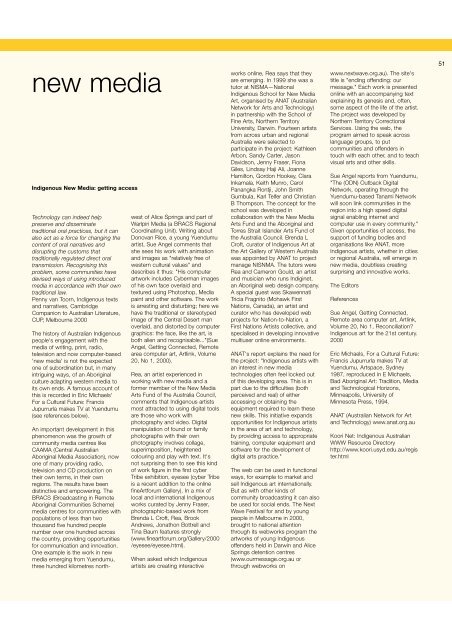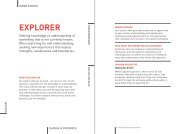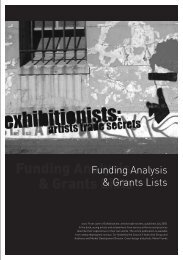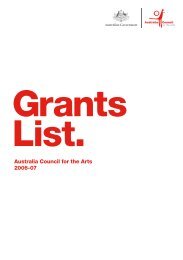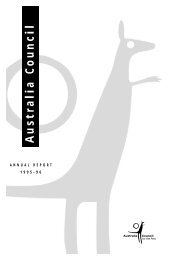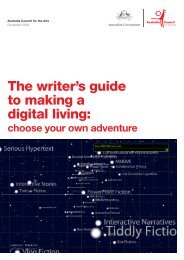Entire document - Australia Council for the Arts
Entire document - Australia Council for the Arts
Entire document - Australia Council for the Arts
Create successful ePaper yourself
Turn your PDF publications into a flip-book with our unique Google optimized e-Paper software.
new media<br />
Indigenous New Media: getting access<br />
Technology can indeed help<br />
preserve and disseminate<br />
traditional oral practices, but it can<br />
also act as a <strong>for</strong>ce <strong>for</strong> changing <strong>the</strong><br />
content of oral narratives and<br />
disrupting <strong>the</strong> customs that<br />
traditionally regulated direct oral<br />
transmission. Recognising this<br />
problem, some communities have<br />
devised ways of using introduced<br />
media in accordance with <strong>the</strong>ir own<br />
traditional law.<br />
Penny van Toorn, Indigenous texts<br />
and narratives, Cambridge<br />
Companion to <strong>Australia</strong>n Literature,<br />
CUP, Melbourne 2000<br />
The history of <strong>Australia</strong>n Indigenous<br />
people's engagement with <strong>the</strong><br />
media of writing, print, radio,<br />
television and now computer-based<br />
'new media' is not <strong>the</strong> expected<br />
one of subordination but, in many<br />
intriguing ways, of an Aboriginal<br />
culture adapting western media to<br />
its own ends. A famous account of<br />
this is recorded in Eric Michaels'<br />
For a Cultural Future: Francis<br />
Jupurrurla makes TV at Yuendumu<br />
(see references below).<br />
An important development in this<br />
phenomenon was <strong>the</strong> growth of<br />
community media centres like<br />
CAAMA (Central <strong>Australia</strong>n<br />
Aboriginal Media Association), now<br />
one of many providing radio,<br />
television and CD production on<br />
<strong>the</strong>ir own terms, in <strong>the</strong>ir own<br />
regions. The results have been<br />
distinctive and empowering. The<br />
BRACS (Broadcasting in Remote<br />
Aboriginal Communities Scheme)<br />
media centres <strong>for</strong> communities with<br />
populations of less than two<br />
thousand five hundred people<br />
number over one hundred across<br />
<strong>the</strong> country, providing opportunities<br />
<strong>for</strong> communication and innovation.<br />
One example is <strong>the</strong> work in new<br />
media emerging from Yuendumu,<br />
three hundred kilometres north-<br />
west of Alice Springs and part of<br />
Warlpiri Media (a BRACS Regional<br />
Coordinating Unit). Writing about<br />
Donovan Rice, a young Yuendumu<br />
artist, Sue Angel comments that<br />
she sees his work with animation<br />
and images as "relatively free of<br />
western cultural values" and<br />
describes it thus: "His computer<br />
artwork includes Cyberman images<br />
of his own face overlaid and<br />
textured using Photoshop, Media<br />
paint and o<strong>the</strong>r software. The work<br />
is arresting and disturbing; here we<br />
have <strong>the</strong> traditional or stereotyped<br />
image of <strong>the</strong> Central Desert man<br />
overlaid, and distorted by computer<br />
graphics: <strong>the</strong> face, like <strong>the</strong> art, is<br />
both alien and recognisable..."(Sue<br />
Angel, Getting Connected, Remote<br />
area computer art, Artlink, Volume<br />
20, No 1, 2000).<br />
Rea, an artist experienced in<br />
working with new media and a<br />
<strong>for</strong>mer member of <strong>the</strong> New Media<br />
<strong>Arts</strong> Fund of <strong>the</strong> <strong>Australia</strong> <strong>Council</strong>,<br />
comments that Indigenous artists<br />
most attracted to using digital tools<br />
are those who work with<br />
photography and video. Digital<br />
manipulation of found or family<br />
photographs with <strong>the</strong>ir own<br />
photography involves collage,<br />
superimposition, heightened<br />
colouring and play with text. It's<br />
not surprising <strong>the</strong>n to see this kind<br />
of work figure in <strong>the</strong> first cyber<br />
Tribe exhibition, eyesee (cyber Tribe<br />
is a recent addition to <strong>the</strong> online<br />
fineArt<strong>for</strong>um Gallery). In a mix of<br />
local and international Indigenous<br />
works curated by Jenny Fraser,<br />
photographic-based work from<br />
Brenda L Croft, Rea, Brook<br />
Andrews, Jonathon Bottrell and<br />
Tina Baum features strongly<br />
(www.fineart<strong>for</strong>um.org/Gallery/2000<br />
/eyesee/eyesee.html).<br />
When asked which Indigenous<br />
artists are creating interactive<br />
works online, Rea says that <strong>the</strong>y<br />
are emerging. In 1999 she was a<br />
tutor at NISMA—National<br />
Indigenous School <strong>for</strong> New Media<br />
Art, organised by ANAT (<strong>Australia</strong>n<br />
Network <strong>for</strong> <strong>Arts</strong> and Technology)<br />
in partnership with <strong>the</strong> School of<br />
Fine <strong>Arts</strong>, Nor<strong>the</strong>rn Territory<br />
University, Darwin. Fourteen artists<br />
from across urban and regional<br />
<strong>Australia</strong> were selected to<br />
participate in <strong>the</strong> project: Kathleen<br />
Arbon, Sandy Carter, Jason<br />
Davidson, Jenny Fraser, Fiona<br />
Giles, Lindsay Haji Ali, Joanne<br />
Hamilton, Gordon Hookey, Clara<br />
Inkamala, Keith Munro, Carol<br />
Panangka Rontji, John Smith<br />
Gumbula, Karl Telfer and Christian<br />
B Thompson. The concept <strong>for</strong> <strong>the</strong><br />
school was developed in<br />
collaboration with <strong>the</strong> New Media<br />
<strong>Arts</strong> Fund and <strong>the</strong> Aboriginal and<br />
Torres Strait Islander <strong>Arts</strong> Fund of<br />
<strong>the</strong> <strong>Australia</strong> <strong>Council</strong>. Brenda L<br />
Croft, curator of Indigenous Art at<br />
<strong>the</strong> Art Gallery of Western <strong>Australia</strong><br />
was appointed by ANAT to project<br />
manage NISNMA. The tutors were<br />
Rea and Cameron Gould, an artist<br />
and musician who runs Indiginet,<br />
an Aboriginal web design company.<br />
A special guest was Skawennati<br />
Tricia Fragnito (Mohawk First<br />
Nations, Canada), an artist and<br />
curator who has developed web<br />
projects <strong>for</strong> Nation-to-Nation, a<br />
First Nations Artists collective, and<br />
specialised in developing innovative<br />
multiuser online environments.<br />
ANAT's report explains <strong>the</strong> need <strong>for</strong><br />
<strong>the</strong> project: "Indigenous artists with<br />
an interest in new media<br />
technologies often feel locked out<br />
of this developing area. This is in<br />
part due to <strong>the</strong> difficulties (both<br />
perceived and real) of ei<strong>the</strong>r<br />
accessing or obtaining <strong>the</strong><br />
equipment required to learn <strong>the</strong>se<br />
new skills. This initiative expands<br />
opportunities <strong>for</strong> Indigenous artists<br />
in <strong>the</strong> area of art and technology,<br />
by providing access to appropriate<br />
training, computer equipment and<br />
software <strong>for</strong> <strong>the</strong> development of<br />
digital arts practice."<br />
The web can be used in functional<br />
ways, <strong>for</strong> example to market and<br />
sell Indigenous art internationally.<br />
But as with o<strong>the</strong>r kinds of<br />
community broadcasting it can also<br />
be used <strong>for</strong> social ends. The Next<br />
Wave Festival <strong>for</strong> and by young<br />
people in Melbourne in 2000,<br />
brought to national attention<br />
through its webworks program <strong>the</strong><br />
artworks of young Indigenous<br />
offenders held in Darwin and Alice<br />
Springs detention centres<br />
(www.ourmessage.org.au or<br />
through webworks on<br />
www.nextwave.org.au). The site's<br />
title is "ending offending: our<br />
message." Each work is presented<br />
online with an accompanying text<br />
explaining its genesis and, often,<br />
some aspect of <strong>the</strong> life of <strong>the</strong> artist.<br />
The project was developed by<br />
Nor<strong>the</strong>rn Territory Correctional<br />
Services. Using <strong>the</strong> web, <strong>the</strong><br />
program aimed to speak across<br />
language groups, to put<br />
communities and offenders in<br />
touch with each o<strong>the</strong>r, and to teach<br />
visual arts and o<strong>the</strong>r skills.<br />
Sue Angel reports from Yuendumu,<br />
"The (ODN) Outback Digital<br />
Network, operating through <strong>the</strong><br />
Yuendumu-based Tanami Network<br />
will soon link communities in <strong>the</strong><br />
region into a high speed digital<br />
signal enabling internet and<br />
computer use in every community."<br />
Given opportunities of access, <strong>the</strong><br />
support of funding bodies and<br />
organisations like ANAT, more<br />
Indigenous artists, whe<strong>the</strong>r in cities<br />
or regional <strong>Australia</strong>, will emerge in<br />
new media, doubtless creating<br />
surprising and innovative works.<br />
The Editors<br />
References<br />
Sue Angel, Getting Connected,<br />
Remote area computer art, Artlink,<br />
Volume 20, No 1, Reconciliation?<br />
Indigenous art <strong>for</strong> <strong>the</strong> 21st century.<br />
2000<br />
Eric Michaels, For a Cultural Future:<br />
Francis Jupurrurla makes TV at<br />
Yuendumu, <strong>Arts</strong>pace, Sydney<br />
1987, reproduced in E Michaels,<br />
Bad Aboriginal Art: Tradition, Media<br />
and Technological Horizons,<br />
Minneapolis, University of<br />
Minnesota Press, 1994.<br />
ANAT (<strong>Australia</strong>n Network <strong>for</strong> Art<br />
and Technology) www.anat.org.au<br />
Koori Net: Indigenous <strong>Australia</strong>n<br />
WWW Resource Directory<br />
http://www.koori.usyd.edu.au/regis<br />
ter.html<br />
51


